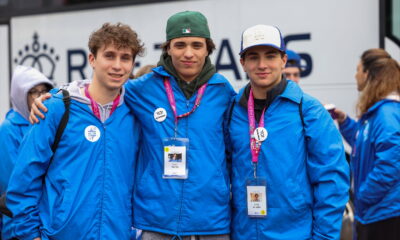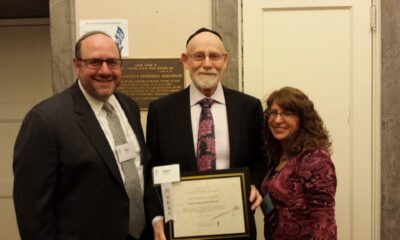Features
Sandra Caplan’s Jewish Journey
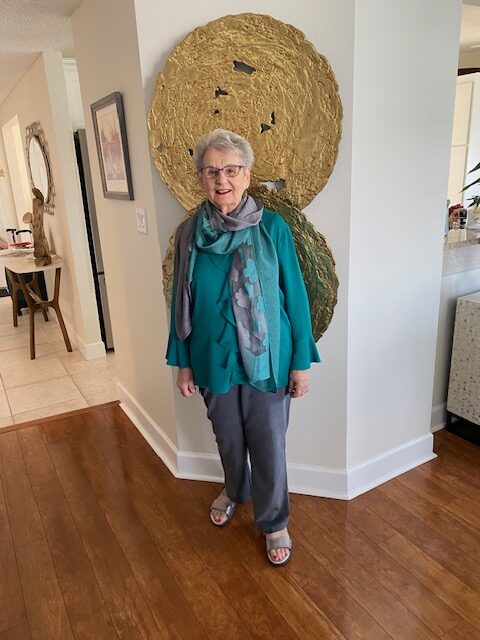
Recently we received an email from Sandra Caplan from her Florida wintertime home. Sandra told us that she had given a talk to her synagogue sisterhood about her life and wondered whether we might be interested in reprinting it.
Sandra’s life followed a path that would be familiar to many Winnipeg Jews (both present and former). So we thought it would be interesting to reprint the story of Sandra’s life here:
The following document, titled My Jewish Journey, was presented to the Sisterhood of Congregation B’nai Israel on March 10th, 2024. I hosted a brunch at my condo in St. Petersburg and spoke of “My Jewish Journey,” the current Rosh Chodesh topic. I am sending a copy of this to my family so that they will have a better understanding of my life. I wrote this in two sessions without an outline. The words flowed from my heart to my brain, my fingers and then to the written page. Please don’t fact find!!
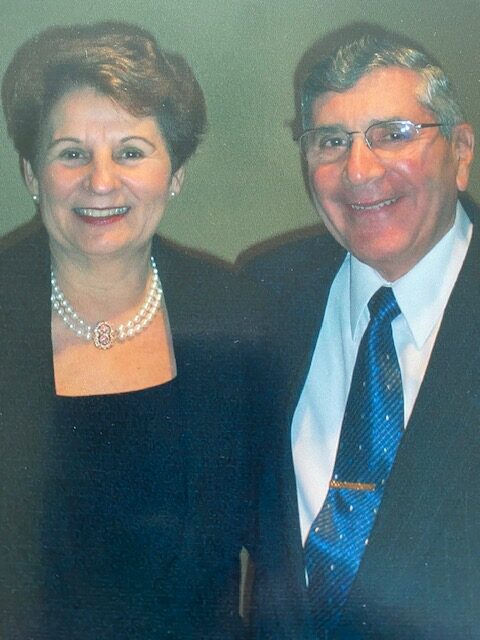
I had two photos that I always bring with me. One is of Barry and me, the other of my family on my eightieth birthday. I also had an atlas so I could show the Floridians where Winnipeg is located. Now on to my story.
The following document, titled My Jewish Journey, was presented to the Sisterhood of Congregation B’nai Israel on May 10th, 2024. I hosted a brunch at my condo in St. Petersburg and spoke of My Jewish Journey, the current Rosh Chodesh topic. I am sending a copy of this to my family so that they will have a better understanding of my life. I wrote this in two sessions without an outline. The words flowed from my heart to my brain, my fingers and then to the written page. Please don’t fact find!! I had two photos that I always bring with me. One is of Barry and me, the other of my family on my eightieth birthday. I also had an atlas so I could show the Floridians where Winnipeg is located. Now on to my story.
MY JEWISH JOURNEY
I am a Snowbird and live in Winnipeg, Manitoba, Canada. Before I speak of My Jewish Journey, I would like to give you a few facts about Winnipeg. It is in the center of Canada and is 2200 miles northwest of St. Petersburg and 500 northwest of Minneapolis. It is a prairie province, and the terrain is flat. The winters are so cold that we often plug our cars into an electric outlet, so that the engine doesn’t freeze. A mild day in the winter would be considered 0 F and a cold day 20 degrees below that. The population in Winnipeg is approximately 750,000 people.
Winnipeg has a Jewish population of about 8,000 people. However, in the 1930’s it was about 20,000. Many young people now leave for what they consider cities with more advantages, such as Toronto, Vancouver and many US cities. Also, families are now smaller. My Mother came from a family of seven and my father from a family of five. Winnipeg has been actively involved in promoting Winnipeg to the Argentinian Jewish community and now has a large group in our community. We also have a large French Canadian, Aboriginal and Filipina presence.
Growing up I always considered that Winnipeg had two areas that the Jewish people lived in-the north end and the south end. I was born in 1939 and lived in the north end. My first recollection is living in a duplex owned by my paternal grandparents who were born in Europe. I was told that the railway line at one point in time ended in Winnipeg and that is why so many Jewish immigrants settled there. Another reason was that there was a homestead plan offered in Manitoba through which new immigrants would be given a plot of land for free if they developed the land. As it turned out the winters were harsh, and the land was inhospitable. The Jewish immigrants were not necessarily experienced in farming and once settled gave up the concept. They turned to commerce and a large percentage of Manitoba’s small towns had Jewish owned general and other stores.
My father was born in Pinsk, Poland. In Winnipeg he became a furrier after high school. My mother was born in Winnipeg and opened a dress shop, Sandra’s, after I was born.
As a young child living on Flora Ave. In the early 1940’s, every house on our street was occupied by Jewish residents. At that time there were about eleven small Orthodox synagogues in the north end. I remember sitting in the balcony at the synagogue with my mother. It was a block from our home. My mother’s parents lived about 10 minutes from our home on Selkirk Ave. My grandmother was a milliner, and her shop was at the front of her home. When my paternal grandparents passed away, the house was sold, and we moved to the south end of the city. I was 5 and after that point can recall much of my Jewish Journey.
In 1945 the south end was considered an upscale area. By this time my father had a men and ladies clothing shop in the Time Bldg. on Portage Ave. My mother still had her shop, Sandra’s. Our family grew with the addition of my brother Frederick (Fred).
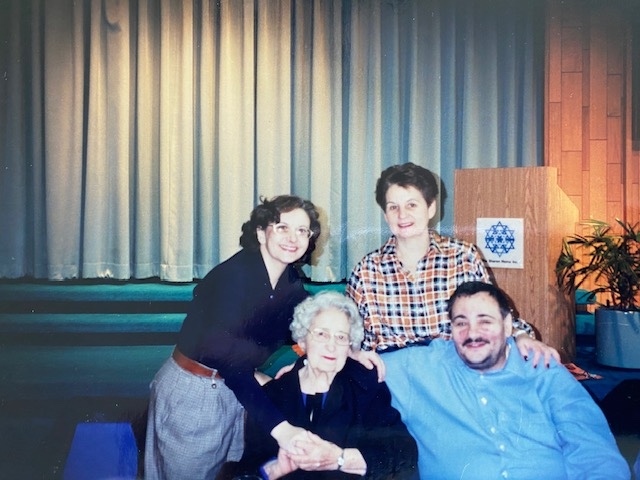
Our home on Oxford Street had several Jewish families. The school that I attended for grade one had very few Jewish kids. It was at the time that my parents decided it was time for my Jewish education to begin. There was not a synagogue in the area, but there was talk of the Shaarey Zedek, which we belonged to moving to the south end. So, as I entered grade two, my Jewish education began, and I attended after school Hebrew classes on Mondays and Wednesdays. The other 2 days were for the students in grades four to six. The classes were held in the basement of a home in the area.
My recollections of those days are quite clear. The kosher butcher delivered twice a week. Since my parents both worked, we had a housekeeper who was an excellent cook. On Friday nights we often had company for dinner. I was Jewish, went to Hebrew school had a strong sense of my religion, but attended the synagogue only on the High Holidays and celebrated other important holidays such as Pesach and of course, Chanukah.
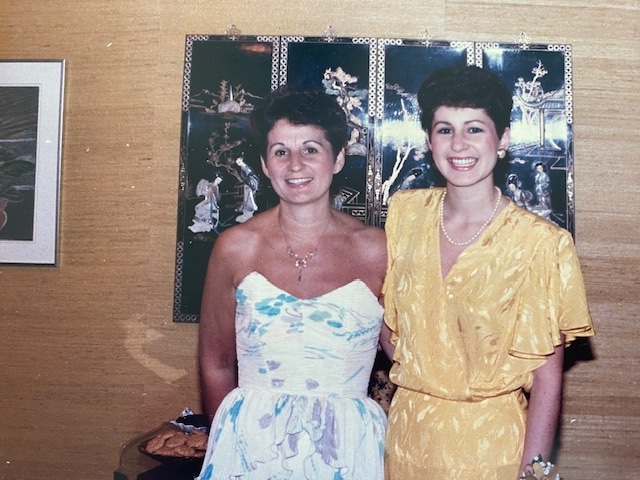
In 1949 my sister Marcia was born. In 1950 my father won the Irish Sweepstake. It was a grand sum of $39,500.00. I tried to translate it to today’s dollar. My thinking was that our home at that time cost $12,500.00. We could have bought 3 homes. That large home today of 4 bedrooms, a den and a finished basement could be worth $800,000. So, I estimate it was like winning $2, 400.000.00 today. With this fortune my father bought property on Portage Ave and built Fredric’s, a large store that sold ladies and men’s wear, sportswear, lingerie, had tuxedo rentals and had a bridal shop on the mezzanine floor.
It was about this time that the synagogue in the south end of town opened. It was a beautiful building on the river. I was able to attend Hebrew school here. It was a gathering place for Jewish children. I was a brownie and a girl scout, and both these activities were at the synagogue.
At that time the synagogue was the center of my Jewish and social life. In 1952 I had a Bat Mitzvah. This was a new ceremony at the conservative Shaarey Zedek synagogue. It was held on a Friday night. The Bat Mitzvah celebrant wore a loose, blue satin mid length long sleeved gown. It had a round collar and a white bow at the collar. I recall standing in front of the ark and reciting a prayer that started—O God and God of my Fathers. With grateful heart I stand before thee—. I also recited a haftorah which began-Vah yishlach Shlomo el Hiram laimor. Atah yadatah—. Obviously, I rehearsed this many times so that sixty-one years later I can still remember a small portion. After the service there was a reception in the social hall. We had party sandwiches, a Winnipeg specialty and favorite to this day, dainties as referred to by non Winnipeggers as squares and cookies and luscious cakes and cookies. Winnipeg Bar and Bat Mitzvah tables are well known in Canadian Jewish circles as are our baking is renowned. I can even remember several gifts that I received. A glass duck with a filling of bubble bath and a small wooden chest filled with note paper and envelopes. I still have that chest today. It was a glorious and happy celebration and did not end my Hebrew studies.
I continued going to Hebrew school until I was confirmed at the age of fifteen. For that ceremony I received a white leatherbound prayer book for the High Holidays which I still have today. When I was a teenager, I sang in the synagogue choir on Shabbat and the High Holidays. Our synagogue had a choir loft which was curtained and on the second floor behind the ark. We had about 20 members led by a choir master.
In Winnipeg in 1956 you could enter University after grade eleven, which I chose to do. So, I was sixteen when I enrolled at the University of Manitoba. Everyone with a few exceptions stayed at home to go to university. In those days we had one Jewish sorority, Iota Alpha Pi which I joined and became the president of in my second year of university. We also had 3 Jewish fraternities known as the Sammies, Zebes and Apes. I took Commerce but did not get my BCom because at the end of my third year I got my MRS.
So, this takes me to dating years in Winnipeg. My friends and I would never think of going out with anyone but a Jewish boy. We all married Jewish boys and married very young. I was nineteen when I married Barry who was a doctor and twenty-six years old. We had a large wedding at the Shaarey Zedek the synagogue that my family attended. Looking back, I feel that I was very young, unworldly leaving my parents to go to Los Angels where Barry would be a resident. I was a young girl in a new and different world! It was a challenge. Our Jewish life as we knew it was at a standstill. I had one Aunt and a few cousins that we could visit and we knew one couple from Winnipeg. There was no time to celebrate holidays and no one to really celebrate with.
California, however, was a nice place to live. We had no Winnipeg winters to deal with but also had no family to be with. Four years passed quickly, especially since we had two children. A daughter Susan who was born in 1962 and a son Bruce born in 1963. I also was fortunate to work at AT&T for 3 years.
Although as I previously said we felt like we had lost some of our Jewishness, a Bris was a ceremony that was very important to us. It was up to Barry to make the arrangements. He spoke to some of the Jewish attending doctors at the hospital. He got the name of a mohel and told my mother, who had come to help me, that the mohel had a request. The baby was to wear a cap and gown. I had no knowledge of Brises and my mother thought this was a little odd. However, we were in the United States. Traditions could be different. When Bruce was 4 days old a cousin came to babysit while my mother and I went shopping for a cap and gown. We found Christening gowns and other outfits for babies. Nothing was suitable for a Bris. I heard of a store in Long Beach that perhaps could help us in our search. I had never been to Long Beach but with directions managed to find the store. We found what we thought was a perfect outfit. It was a white cotton Carters gown that was tied at the bottom with a matching bonnet that was tied under the baby’s neck. The day of the Bris arrived and we met the Mohel. His first question to Barry was “did you bring my cap and gown from the hospital”. As an excited father Barry was so happy to find a Mohel he heard only the cap and gown and assumed it was for the baby. Fortunately, we lived a few minutes from the hospital and Barry was able to ge the cap and gown for the Mohel. Later the Mohel remarked that he thought the baby’s outfit was a little strange. Our first, but certainly not our last adventure with our son.
In 1963 we returned to Winipeg and a whole new Jewish Journey for me was established. Barry had a very large, observant family on his maternal and paternal side. So, I became immersed in all the Jewish culture of his family. My side of the family was small, and we were not as close as the Caplan/Stall family. I was twenty-three. A mother of two, naive, inexperienced and the product of a sheltered life. How did I survive? I guess that necessity was a factor. We adapted to life in the city, made friends, and carried on. The Caplan family belonged to the synagogue in the north end of town. My family belonged to the synagogue in the south end. Until our daughter Susan was twelve, we went to Rosh Pina with the Caplans. One incident that I clearly remember took place on the High Holidays in about 1969. We never joined the synagogue as Barry’s parents looked after our High Holiday tickets and with Barry’s work schedule as a Urologist who was on call every third weekend and every third of fourth night, he was not able to commit to going to shule. To get back to the holiday service the Rabbi spoke about membership in the synagogue and its importance in Jewish life. I felt he was looking directly at me as he made this appeal. On the way home I said to Barry that we must join the synagogue. It is a priority in our lives. As Susan’s Bat Mitzvah approached, I had a problem. Our children attended Ramah day school but lessons for your Bar /Bat Mitzvah and the ceremony, took place at the synagogue that you belonged to. In my mind I had no choice. To drive twice a week to the north end when it could be very cold, icy streets and a huge distance of a half hour was beyond my scope of reality. So, we joined the south end Shaarey Zedek Synagogue. Our son Bruce had his Bar Mitzvah in 1976 at the Shaarey Zedek and our son David who was born in 1971 completed this cycle.
While raising my family I was involved in Hadassah and National Council of Jewish Women. I became president of the chapters that I belonged to and was actively involved in both. I also volunteered at the Shaarey Zedek in a lunch program for seniors. Being in shule, whether as a volunteer or at a service or program was always an important part of my life. When my husband Barry retired in December 1999 we started coming to St. Petersburg for the winter. One of our first projects was to find a conservative synagogue. How fortunate we were to discover CBI.When we got home that spring, we started going to service every Saturday and this continued until Barry’s passing. I continued to attend until Covid and the two-year remodeling of our synagogue began. Our renovations are almost complete, and my family and I will be able to return to our beloved Shaarey Zedek for the holidays this year and I will return to my weekly Saturdays at shule.
Jewish holidays are a special time in our family. Last Rosh Hashanah my daughter Susan and I continued the family tradition of a luncheon on the first day of the holiday. This was held at her home. How wonderful that first to fourth cousins, machatunim and those close to the family gather to enjoy this holiday. I have been in touch with a cousin in Winnipeg to check on the first Seder for this year. My children are coming to Winnipeg from Vancouver, and we look forward to enjoying the Seder with the extended family again. This year we will probably have thirty attending but often there are many more.
When I speak of the synagogue and the importance of it in our family life, I cannot help but think of the day of Barry’s passing. I came into his hospital room and his first word was shule. I immediately called the synagogue, spoke to Rabbi Green and within a half hour he was at Barry’s bedside, singing and reciting prayers. How fortunate we are to have a religion and a life that makes us feel involved, loved and able to pass away in what we would consider a dignified and peaceful manner. As I write these words tears stream down my face and I realize how fortunate I am to have been born Jewish.
I truly feel that I could end my Jewish Journey here, but life goes on after the loss of loved ones. For six and a half years I have been a widow. My friends hate that word, but I can’t say that I am alone. That is not true. I have a wonderful family, friends and a full life. I come to Florida for the winter, I can travel with my daughter, I visit my children and grandchildren in Vancouver, I enjoy the cultural life in my two favorite cities and much more.
I feel that life has been good to me. I have three children, six grandchildren, many friends, good health and the ability to enjoy life. I have truly been blessed.
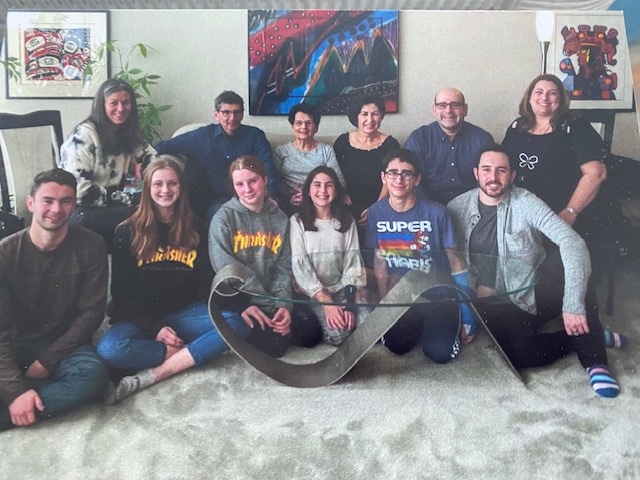
BACK ROW L – R: Sheri Winters, Bruce Caplan, Sandra Caplan, Susan Billinkoff, David Caplan, Cindy Switzer
Front Row L – R: Asher Billinkoff, Maia Caplan, Annie Caplan, Layla Switzer-Caplan, Max Switzer Caplan, Jordan Billinkoff
Features
Three generations of Wernicks all chose to become rabbis

By GERRY POSNER Recently I was at a Shabbat service at Beth Tzedec Synagogue in Toronto and the day unfolded in some unexpected ways for me.
It began when I was asked to be a Gabbai for the service, that is to stand up at the table where the Torah is placed and to check the Torah reading to make sure there are no errors. I have done this before and it has always gone smoothly. I attribute that fact in large part to the Torah reading ability of the reader at Beth Synagogue. He is fast, fluent and flawless. Well, on this particular day after he had completed the first two portions, he began the shlishi or third aliyah. I could not find his reading anywhere. It was as if he had started somewhere fresh, but not where he was supposed to be. I looked at the other Gabbai and he did not seem to recognize what had happened either. So, I let it go. I had no idea where the Torah reader was. He then did another and still I was lost. He came to what was the 6th aliyah when a clergy member walked over to him and indicated to him that he had read the fourth and fifth aliyah, but that he had missed the third one. The Torah reader then said to me “this is what you are here for.” Now, it might have been one thing if I had missed it entirely. Alas, I saw the error, but let it go as I deferred to the Torah reader since he never makes a mistake. He ended up going back to do the third aliyah before continuing on. This was a very unusual event in the synagogue. I felt responsible in large part for this gaffe. A lesson learned.
The feeling of embarrassment was compounded by the fact that on this particular day the service was highlighted, at least for me, because of the rabbi delivering the sermon. This rabbi, Eugene Wernick, was none other than the father of my present rabbi, Steven Wernick of Beth Tzedec Synagogue. He was also the same rabbi who was the rabbi at Shaarey Zedek between 1979-1986 and who had officiated at my father’s funeral in 1981, also a few years later at my oldest son’s Bar Mitzvah in Winnipeg in 1984. As I listened to him speak, I was taken back to the 1980s, when Rabbi Gene was in the pulpit at Shaarey Zedek. Of course, he is older now than in his Shaarey Zedek days, but the power of his voice was unchanged. If anything, it’s even stronger. As in the past, his message was relevant to all of us and resonated well. Listening to him was a treat for me. Still, my regret in not calling out the mistake from the Torah reading was compounded by the fact that I messed up in front of my former rabbi, Eugene Wernick – never mind my present rabbi, Steven Werinck.
On this Shabbat morning, aside from all the other people present, there were not only the two Rabbis Wernick, but one Michelle Wernick was also there. Michelle, daughter of Rabbi Steven Wernick, is a first year student at the Jewish Theological Seminary. She is following in the family business – much like with the Rose rabbinical family in Winnipeg.
As it turned out, there was a Bat Mitzvah that day. And the Bat Mitzvah family had a very real Winnipeg connection as in the former Leah Potash, mother of the Bat Mitzvah girl, Emmie Bank and the daughter of Reuben and Gail Potash (Thau). It occurred to me that there might be a few Winnipeg people in the crowd. As I scanned the first few rows, I was not disappointed. Sitting there was none other than Chana Thau and her husband Michael Eleff. I managed to have a chat with Chana (even during the Musaf service). In the row right behind Chana and Michael was a face I had not seen in close to sixty years. I refer to Allan Berkal, the eldest son of the former rabbi and chazan at Shaarey Zedek, Louis Berkal. I still remember the first time I met Allan at Hebrew School in 1954 when his family moved to Winnipeg from Grand Forks, North Dakota. That was many maftirs ago. So this was another highlight moment for me.
Of course, there are other Winnipeggers who attend Beth Tzedec most Shabbats. I speak of Morley Goldberg and his wife, the former Marcia Billinkoff Schnoor. As well, Bernie Rubenstein and his wife, the former Sheila Levene were also present for this particular Shabbat. In all, this Shabbat had a particularly Winnipeg flavour to it. Truth be told, you do not have to go far in Toronto at any synagogue and the Winnipeg connections emerge.
Features
In Britain Too, Jews Are in Trouble

By HENRY SREBRNIK Antisemitic attacks in Britain have surged to levels unseen in decades, with Jewish schools under guard and synagogues routinely targeted. Jews suffered the highest rate of religious hate crimes in the year ending March 2025, according to interior ministry data. And it has only become worse.
Jewish Post and News readers know, of course, about the attack on Jewish worshippers at the Heaton Park Synagogue in Manchester at Yom Kippur services on October 2, 2025. The attack killed Adrian Daulby, 53, and Melvin Cravitz, 66, and left three others injured.
Greater Manchester Police Chief Sir Stephen Watson said fear within the Jewish community had risen sharply, with even young children asking for armed police protection to simply attend Hanukkah parties.
While the blame for the violence lies with the assailant, an immigrant from Syria, who was shot dead by police, the responsibility for the circumstances in which two Jews died and where a Jewish community that has contributed loyally to British society for centuries fears for its existence lies with the leaders of the British establishment.
The Labour government, many of whose supporters and elected representatives flirt with pro-Hamas positions, has fueled the flames with its denunciations of Israel’s war and recognition of a Palestinian state. Many younger people, their minds filled with postmodern “anticolonialist” left ideology, are eager recruits to the cause.
Ruth Deech is a British academic, bioethicist and politician who sits in the House of Lords. Ten years ago, she warned that some of the country’s top universities had become “no-go zones” for Jewish students. But, in the wake of the October 7 atrocities and ensuing war in Gaza, she believes the situation is much worse.
“The warfare on the streets is being continued in the universities,” Deech told the Times of Israel Dec. 25. “The universities on the whole are not facing up to it, and the University of London campuses are probably amongst the worst. None of the vice chancellors seem to be able to summon up the courage to deal with it,” Deech contends.
“They take refuge behind freedom of speech, without realizing that freedom of speech stops where hate language begins.” Deech is highly critical of Oxford, where she has spent much of her academic life. British universities must take stronger action to protect Jewish students and use every tool available to confront hate and division.
But the reaction by authorities has generally been one of appeasement. For years, police refused to enforce hate-crime laws. Universities tolerated mobs chanting for Israel’s destruction. Politicians equivocated in the name of “balance.”
For instance, in Birmingham, the West Midlands Police, which cover the city, classified as “high risk” a soccer match between Maccabi Tel Aviv and Aston Villa on Nov. 6. The police cited “safety” as the reason for banishing fans of the Tel Aviv team, which now seems to be standard when unjustified bans are put in place.
As the Jewish Leadership Council noted on X, “It is perverse that away fans should be banned from a football match because West Midlands Police can’t guarantee their safety.” Prior to the event, masked men hung “Zios Not Welcome” signs in the windows of shops or restaurants. “Zio,” of course, is a not-so-coded word for Israelis and/or Jews.
Over the past two years, the Board of Deputies of British Jews, the country’s main representative body for the Jewish community, has faced questions of their own about how to conduct debates on Israel. Last April, 36 of the board’s members signed an open letter, which was published in the Financial Times, protesting against “this most extremist of Israeli governments” and its failure to free the hostages held since October 7. “Israel’s soul is being ripped out and we fear for the future of the Israel we love,” the letter read.
Five members of the Board were suspended for instigating the letter. The Board’s Constitution Committee found that they had broken a code of conduct by creating the “misleading impression that this was an official document of the Board as a whole.” But for some, the letter represented a watershed moment where some of the conversations about Israel happening in private within the Jewish community could be had in public.
Board President Phil Rosenberg argued that there has long been healthy debate among the 300 deputies. His primary concern is the safety of British Jews but also how the community sees itself. “We have a whole range of activities to confront antisemitism,” he maintained. “But we also believe that the community needs not just to be seeing itself, and to be seen, through the prism of pain.
“It already wasn’t right that the only public commemoration of Jewish life in this country is Holocaust Memorial Day. And the only compulsory education is Holocaust education. Both of these things are incredibly important, but that’s not the whole experience of Jews.”
Given all this, a new political party divide is emerging among British Jews, with support rising fast for the left-wing Greens, now led by Zack Polanski, who is Jewish, and buoyed by younger and “anti-Zionist” Jews, while the older Orthodox turn to Nigel Farage’s upstart right wing Reform UK, as trust in the two main parties collapses.
Support for Labour and the Conservatives among British Jews had fallen to 58 per cent by July 2025 from nearly 84 per cent in 2020, according to a November 2025 report from the Institute of Jewish Policy Research (JPR), entitled “The End of Two-party Politics? Emerging Changes in the Political Preferences of British Jews.”
Labour has been typically favoured by more “secular” Jews while the Conservative party is traditionally preferred by more “observant” Jews. But for the first time in recent British Jewish history, support for the Labour and Conservative parties combined has fallen below 60 per cent.
“Reform UK is more likely to attract male, older, orthodox, and Zionist Jews; the Greens are more likely to attract younger, unaffiliated and anti-Zionist,” according to Dr. Jonathan Boyd, JPR’s executive director. The surge in Jewish support for Reform UK, a party whose rhetoric on immigration and nationalism would typically be expected to alienate minority communities, including Jews,” was described as “striking” by the JPR.
“Significant parts of the Jewish population may gravitate toward voices promising strength and clarity, regardless of ideological baggage” when mainstream parties were perceived as “weak or hostile,” the report added. “It may signal a structural shift in Jewish political identity.”
Three forces appear to be driving this fragmentation: the war in Gaza and its polarising effect on Jewish attitudes; rising antisemitism, culminating in the Heaton Park Synagogue terrorist attack; and a broader collapse of trust in mainstream parties.
“Together, these factors are pushing Jews toward parties that offer clarity — whether through populism or radical progressivism. If recent developments persist,” the report suggested, “British Jews are likely to become more politically polarised, prompting further internal community tensions.”
Henry Srebrnik is a professor of political science at the University of Prince Edward Island.
Features
So, what’s the deal with the honey scene in ‘Marty Supreme?’

By Olivia Haynie December 29, 2025 This story was originally published in the Forward. Click here to get the Forward’s free email newsletters delivered to your inbox.
There are a lot of jarring scenes in Marty Supreme, Josh Safdie’s movie about a young Jew in the 1950s willing to do anything to secure his spot in table tennis history. There’s the one where Marty (Timothée Chalamet) gets spanked with a ping-pong paddle; there’s the one where a gas station explodes. And the one where Marty, naked in a bathtub, falls through the floor of a cheap motel. But the one that everybody online seems to be talking about is a flashback of an Auschwitz story told by Marty’s friend and fellow ping-ponger Béla Kletzki (Géza Röhrig, best known for his role as a Sonderkommando in Son of Saul).
Kletzki tells the unsympathetic ink tycoon Milton Rockwell (Kevin O’Leary) about how the Nazis, impressed by his table tennis skills, spared his life and recruited him to disarm bombs. One day, while grappling with a bomb in the woods, Kletzki stumbled across a honeycomb. He smeared the honey across his body and returned to the camp, where he let his fellow prisoners lick it off his body. The scene is a sensory nightmare, primarily shot in close-ups of wet tongues licking sticky honey off Kletzki’s hairy body. For some, it was also … funny?
Many have reported that the scene has been triggering a lot of laughter in their theaters. My audience in Wilmington, North Carolina, certainly had a good chuckle — with the exception of my mother, who instantly started sobbing. I sat in stunned silence, unsure at first what to make of the sharp turn the film had suddenly taken. One post on X that got nearly 6,000 likes admonished Safdie for his “insane Holocaust joke.” Many users replied that the scene was in no way meant to be funny, with one even calling it “the most sincere scene in the whole movie.”
For me, the scene shows the sheer desperation of those in the concentration camps, as well as the self-sacrifice that was essential to survival. And yet many have interpreted it as merely shock humor.
Laughter could be understood as an inevitable reaction to discomfort and shock at a scene that feels so out of place in what has, up to that point, been a pretty comedic film. The story is sandwiched between Marty’s humorous attempts to embarrass Rockwell and seduce his wife. Viewers may have mistaken the scene as a joke since the film’s opening credits sequence of sperm swimming through fallopian tubes gives the impression you will be watching a comedy interspersed with some tense ping-pong playing.
The reaction could also be part of what some in the movie theater industry are calling the “laugh epidemic.” In The New York Times, Marie Solis explored the inappropriate laughter in movie theaters that seems to be increasingly common. The rise of meme culture and the dissolution of clear genres (Marty Supreme could be categorized as somewhere between drama and comedy), she writes, have primed audiences to laugh at moments that may not have been meant to be funny.
The audience’s inability to process the honey scene as sincere may also be a sign of a society that has become more disconnected from the traumas of the past. It would not be the first time that people, unable to comprehend the horrors of the Holocaust, have instead derided the tales of abuse as pure fiction. But Kletzki’s story is based on the real experiences of Alojzy Ehrlich, a ping-pong player imprisoned at Auschwitz. The scene is not supposed to be humorous trauma porn — Safdie has called it a “beautiful story” about the “camaraderie” found within the camps. It also serves as an important reminder of all that Marty is fighting for.
The events of the film take place only seven years after the Holocaust, and the macabre honey imagery encapsulates the dehumanization the Jews experienced. Marty is motivated not just by a desire to prove himself as an athlete and rise above what his uncle and mother expect of him, but above what the world expects of him as a Jew. His drive to reclaim Jewish pride is further underscored when he brings back a piece of an Egyptian pyramid to his mother, telling her, “We built this.”
Without understanding this background, the honey scene will come off as out of place and ridiculous. And the lengths Marty is willing to go to to make something of himself cannot be fully appreciated. The film’s description on the review-app Letterboxd says Marty Supreme is about one man who “goes to hell and back in pursuit of greatness.” But behind Marty is the story of a whole people who have gone through hell; they too are trying to find their way back.
Olivia Haynie is an editorial fellow at the Forward.
This story was originally published on the Forward.


